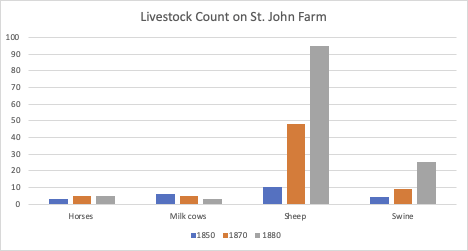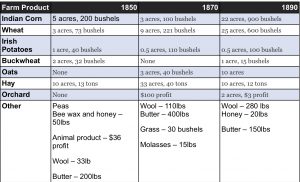
S.W. St. John purchased his first 80 acre farm in 1842. His house was located just south of Sand Ridge Road, the current southern border of St. John/Wintergarden Preserve. In the Great Black Swamp region, the most valuable land during European settlement was along sand ridges. This was the land that was first settled by people entering the swampy region. Bowling Green was one of the highest points in the swamp, making our community the perfect place to start a farm and raise a family. St. John likely reached Bowling Green early in the history because he was able to claim such a large plot of land along the most valuable part of the city.
St. John was well known throughout the region for his animal and crop agriculture. In the fall of 1874, St. John won the county fair award for best late peaches. The family had two acres of a fruit orchard near their home in 1880. This same year the family had 95 sheep. They grazed these animals in the wood lot, which we know as St. John’s Woods. One sheep requires 0.5 acres of land. With a flock that large, the wood lot would have been between 38 and 45 acres. Around the time of peak flock count, St. John was the superintendent of sheep at the county fair. The St. John family also grew corn, wheat, potatoes, oats, hay, and buckwheat. They even collected honey from their beehives for several years. These products were sold for profit to maintain the farm and sustain the family. Many decades of farm products were recorded in the Census records.
Production in St. John’s Farm, 1850 to 1880
Silvopasturing is the integration of forest landscapes and grazing livestock. Imagine walking through St. John’s Woods at St. John/Wintergarden Preserve and hearing bleating before coming across a group of sheep munching on grasses. This is what we believe occurred in the current St. John’s Woods area in the late-1800s. There are several fence posts located on the edges of the woods, suggesting that St. John put his sheep in the forest to graze, keeping them there with fences around the perimeter. Another piece of evidence that suggests that silvopasturing was the practice is the presence of wildflower and grass species that would taste acidic to livestock. The plants that are not as acidic are no longer present in the preserve. If humans entered a forest where the grass was made of chocolate, there would be no more chocolate grass several generations into the future. All that would be left would be the regular grasses. This is what has happened in the St. John/Wintergarden Preserve.
Silvopasturing is seen as a modern, sustainable agriculture practice. The results of grazing livestock in forested areas include higher nutrition for livestock, higher value of woodland products, erosion protection, minimization of mowing, and more. If silvopasturing was used in the 1800s and is a sustainable practice, what does this mean for sustainable farm practices today? Should we be looking back at the St. John farm to glean aspects of sustainable farming that we can use in Wood County agriculture?
In continuing the discussion of agriculture, the campaign to obtain previously farmed land on the west side of the park is an attempt to grow the park and to continue telling the histories of local farmers and agriculture in Wood County. Click here to learn more about the Bowling Green Parks and Recreation Foundation or to donate to the campaign.
Learning More
If you are interested in learning more about silvopasturing and historic uses of Black Swamp farms, check out these additional resources:
- U.S. Department of Agriculture post about silvopasturing on 21st century farms
On local history and narratives of farming, see The Great Black Swamp: Historical Tales of 19th Century Northwest Ohio by Jim Mollenkopf, and Howard E. Good, Black Swamp Farm (Columbus: Ohio State University Press, 1997, click here to open.)
Sources
- Census Year: 1850; Census Place: Plane, Wood, Ohio; Archive Collection Number: T1159; Roll: 11; Line: 10; Schedule Type: Agriculture. U.S., Selected Federal Census Non-Population Schedules, 1850-1880.
- Kaatz, Martin R. “The Black Swamp: A Study in Historical Geography”. Annals of the Association of American Geographers, 45:1, pp. 1-35. Mar. 1955.
- Kintzel, Ulf. “Carrying Capacity with Sheep”. Farming Magazine, pp. 12-15.
- Sentinel-Tribune, October 1 1874.
- “Silvopasture.” USDA, National Agroforestry Center. https://www.fs.usda.gov/nac/practices/silvopasture.ph.
Text, research and content created by Madison Stump, B.A. student majoring in Environmental Policy and Analysis. Edited by Dr. Amílcar Challú, Associate Professor of History, Bowling Green State University, and Carolyn Dailey, history senior.


